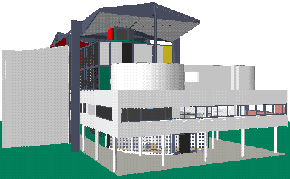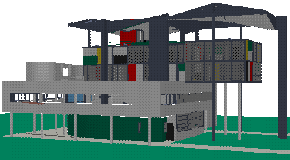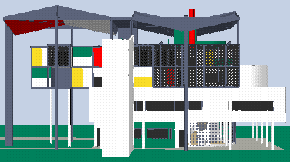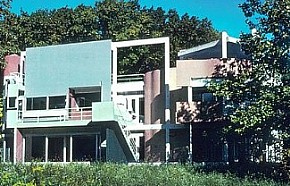2008.05.15 08:17
Now try taking it to court.
For the record:
"The duck is the special building that is a symbol; the decorated shed is the conventional shelter that applies symbols. We maintain that both types of architecture are valid--Chartres is a duck (although it is a decorated shed as well), and the Palazzo Farnese is a decorated shed--but we think that the duck is seldom relevant today, although it pervades Modern architecture."
--Learning from Las Vegas, four years after 1968.
Perhaps the case today is that the duck has become (via media) more relevant (to society), and the decorated shed has become more (true to form) ephemeral. I maintain that both these types of architecture are valid.
2008.05.16 08:16
Now try taking it to court.
Point one begins with "Media has invaded every aspect of our lives." and ends with "Just think of any architectural magazine today devoted, supposedly, to the environment, and instead one finds media."
More to the point: Advertising has invaded every aspect of our lives, and just think of any architectural magazine today devoted, supposedly, to the environment, and instead one finds advertising.
"In the future, everything will be an advertisement."
--Rita Novel
The Guggenheim has very successfully, via architecture, become an advertisement of itself [via free press even]. The Guggenheim's architecture as advertisement has even become an aspect of the Guggenheim's sustainability. The image of Guggenheim buildings are trademarked even.
Perhaps...
Architecture as delivery of content = architecture as delivery of "advertising space" = lucrative sustainability. (We already know this is how a lot of virtual architecture works.)
Point one in the middle reads, "This leads today to a corruption of what we think of as communication, with a lessening of the capacity to read or write correct sentences." Ikea began their 1985 campaign in the United States with many billboards all over Philadelphia simply communicating--
 + +  + AH! + AH!
--months before the one store even opened.
I've lately come to wonder whether Ikea picked Philadelphia first because it is the largest city in what in the mid-seventeenth century was indeed New Sweden. Post-colonialism Swedish style I suppose.
Architecture in a media culture indeed!
2008.05.16 07:37
The Official Paradigm Shift thread
One easy way to conceptualize a new paradigm is to invert the "set of assumptions, concepts, values, and practices that constitutes a way of viewing reality". Such a conceptualization, however, does not then necessarily render a shift in paradigm.
New paradigms are easy to conceptualize, but getting "the community" to share (shift to) a new paradigm requires a lot more work.
War almost always renders a paradigm shift.
| |
2008.05.16 11:09
The Official Paradigm Shift thread
"For example there were reasons in the late 19th century for architecture to change. These included changes in psychology introduced by Freud; in physics by Einstein; in mathematics with Heisenberg; and in flight with the Wright brothers. These changes caused a reaction against the Victorian and imperial styles of the period and articulated a new paradigm: modernism."
What the physics of Einstein, the mathematics of Heisenberg and the flight of the Wright brothers changed much more than architecture was warfare. [Freud basically applied the Christian notion of divine trinity being to the human psyche, thus helping humans to see themselves (and even Freud himself) as more Christian god-like.]
"With each new paradigm, whether it is the French revolution or the Renaissance, there is an early phase, which in modernism was from 1914-1939; a high phase, which in modernism occurred 1954-1968 when it was consumed by liberal capital after the war; and a period of opposition. The year 1968 saw an internal, implosive revolution, one that reacted against institutions representing the cultural past of many of the western societies. This was followed by post modernism's eclectic return to a language that seemed to have meaning. The Deconstructivist exhibition at the MoMA in 1988 put an end to this cliché and kitsch style."
First off, I wonder what the early, high and post-modern phases of the French Revolution are.
Note how modernism (as described here) does not have a phase between 1939 and 1954, i.e., during WWII and its aftermath. It looks like WWI and WWII and even the Vietnam War had a far greater effect on modernism than anything else.
So what does "war" look like in the world of architecture? Maybe, just maybe, it looks like a complete inversion of all of the above. (Like I said already, paradigm shifts require a lot of work.)
2008.05.16 13:58
The Official Paradigm Shift thread
Just paged through Le Corbusier's Oeuvre Complete 1938-46 and Oeuvre Complete 1946-52 and saw a lot of precursiveness. Like a whole magazine of paradigm-shifting bombs.
2008.05.17 16:06
The Official Paradigm Shift thread
"But here is my attempt at a definition of mannerism in architecture appropriate to now:
Mannerism as Convention Tweaked--or as Modified Cnvention Acknowledging Ambiguity. Mannerism for architecture of our time that acknowledges conventional order rather than original expression but breaks the conventional order to accomodate complexity and contradiction and thereby engages ambiguity unambiguously. Mannerism as complexity and contradiction applied to convention--as acknowledging a conventional order that is then modified or broken to accomodate valid exceptions and acknowledge unambiguous ambiguities for an evolving era of complexity and contradiction--rather than acknowledge no order or acknowledging a totality of exceptions or acknowledging a new order so as to be original."
--Robert Venturi, Architecture as Signs and Systems, pp. 74-5.
"...I would add that you break the rules because you can't follow all the rules of all the systems all the time, or at the same time. For one thing, some will be in conflict.
So conflict between systems is a condition that evokes Mannerism."
--Denise Scott Brown, Architecture as Signs and Systems, p. 212.
(I'll have to admit limited knowledge/experience on this, but...)
Is not a primary aspect of designing via algorithmic diagramming one where "tweaks" to the program are continually accomodated throughout the entire program, thus the endproduct never exhibits stand-out exceptions, but rather exceptions that are "massaged-in", thus the endproduct is a continuum overall, and ambiguity in never even present?
Is "ambiguous algorithm" an oxymoron?
How might a mannered algorithm function?
Can algorithms treat ambiguity unambiguously?
What (mostly) Venturi describes as mannerism in architecture may well be that aspect of designing that artificial intelligence can never quite achieve.
| |
2008.05.19 18:28
Now try taking it to court.
Regarding Charles Sanders Peirce, see Anthony Vidler's "What is a Diagram anyway?" in Peter Eisenman: Feints.
e.g.:
"Perhaps the most penetrating examination of the nature and role of diagrams was undertaken by Charles Sanders Peirce (1839-1914), in context of his general theory of signs, his semiology. For Peirce, all thinking took place with signs, things which served "to convey knowledge of some other thing", which they were "said to stand for, or represent."
2008.05.20 08:49
The Official Paradigm Shift thread
HQ of DATA



Department of Architectural Theory Annexation
"Hey, do you mind taking a picture of me in front of a paradigm shift on top of a paradigm shift."
| |
2008.05.20 11:50
The Official Paradigm Shift thread
Many OMA and MVRDV projects owe a debt to Le Corbusier's Palais des Congrès (1964, shown here with the exterior walls of the upper box removed). A generic stacked grid filled with a wide variety of program. Le Corbusier's 'baroque' reenactment of Villa Savoye, even.
The Heidi Weber Pavilion is a composite of (at least) two earlier (1949-50) design ideas: Le Brevet 226x226x226 and Porte Maillot 50. The various designs leading up to and the early designs of the Pavilion itself make for an interesting study in 'paradigm' development.
Sous les Paves la Plage, indeed.
2008.06.01 11:14
The Official Paradigm Shift thread
"On the one side was Nature: the curves of the waves, the line of the unfolding leaf, the pattern of the crystal. All these might be studied, and in some way architecturally employed--no matter how--so long as the knowledge and the love of them were evident."
--Geoffrey Scott, The Architecture of Humanism: A Study in the History of Taste, (1914), p. 68.
2008.06.28 09:21
the miller house (should be more famous)
 Looks like late Le Corbusier style as Composite Order--Villa Shodham meets Heidi Weber Pavilion meets Chandigarh tapestries.
Looks like late Le Corbusier style as Composite Order--Villa Shodham meets Heidi Weber Pavilion meets Chandigarh tapestries.
What was the year of construction?
Evokes some memories of Graves' Snyderman House.

| |
2008.06.30 15:24
the miller house (should be more famous)
"Ah, Detailotheca, the nimiety of detail museum."
"If only all architecture were so self-evident."
"I know. It never really was a house, was it?"
"True, but it's actually two museums."
"Ah yes, the Reenactment of Late Le Corbusier Style Museum as well."
2008.07.05 11:44
architecture, technology, magic & war
The point of the great pyramids today is exactly that they make no sense; we don't even know how they were built. And, unless you believe in magic, the pyramid builders used a 'technology' that is somehow beyond us right now.
Just kill the notion of "how things were always done" because that's the real myth of your argument. "How things are done" has always been a very non-homogeneous set of situations. If you look closely, computers have (already) greatly enabled an even more vast proliferation of non-homogeneous ways of doing things.
There is a detectable magic in true non-homogeneous visionariness.
Historiography is now paradoxically caught up with writing predictions of the future, and that's because a true (magical) historian actually can simultaneously write about past, present and future events.
2008.07.06 11:15
How "futuristic" really is SCI_arc?
Is there a way to photoshop not by HAND?
Drawing and collaging by WORD OF MOUTH, now that's futuristic!
2008.07.09 18:24
Help on Wall label or object label in a museum
"The paradox is that architects work so hard at not working, sacrificing evenings, weekends, retirement, and even old age. The architect is a piece of equipment that is always on, with a screen saver of routine activities that represents action when nothing is happening. Every casual look when walking down the street or into a room is turned into an analytical, dissecting gaze."
--Wigley
You often find such topical caricatures of architects within the essays of Wigley from the last decade or so.
2008.07.14 10:06
bored with modern & contemporary, yet?
"Then I thought, might it not be interesting if homes were treated/designed like BIG BOX stores."
It could well be argued that the Villa Savoye is a fitting representation or acme even of the paradigm shift in residential architecture toward overall minimalism. The skeleton of a minimalist building is even more minimal (or see Farnsworth House). Then came the decorated shed with minimalist decoration. And in the virtual present gemmating decorated sheds infringing upon minimalist remains.
|